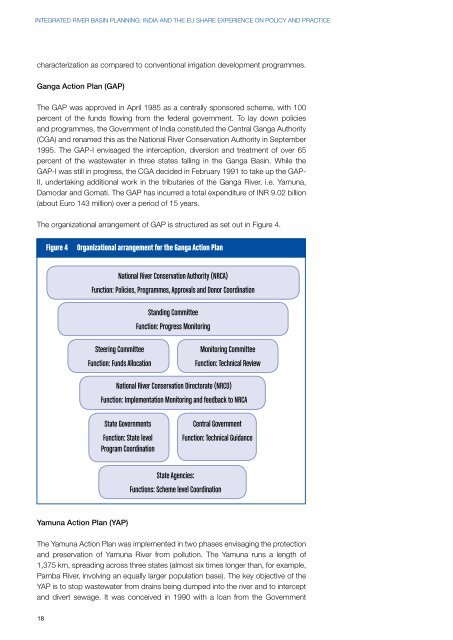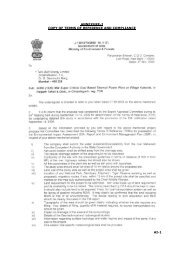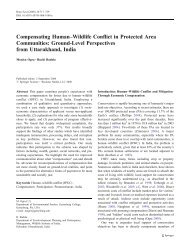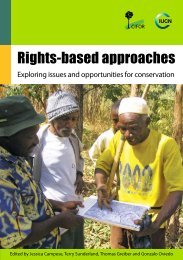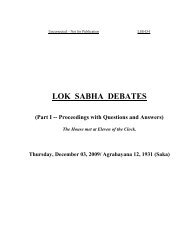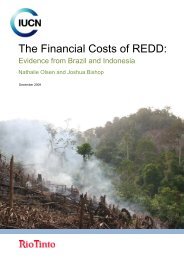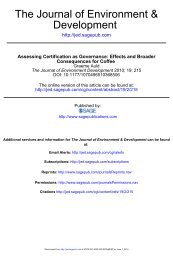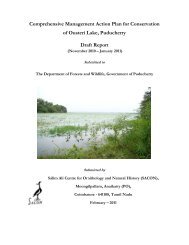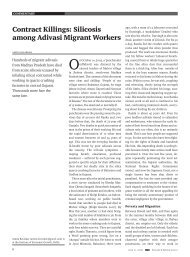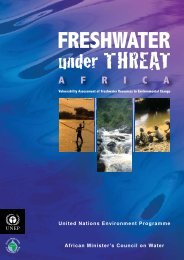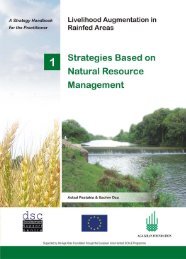Integrated River Basin Planning – Replicable ... - India Water Portal
Integrated River Basin Planning – Replicable ... - India Water Portal
Integrated River Basin Planning – Replicable ... - India Water Portal
Create successful ePaper yourself
Turn your PDF publications into a flip-book with our unique Google optimized e-Paper software.
<strong>Integrated</strong> <strong>River</strong> <strong>Basin</strong> <strong>Planning</strong>: <strong>India</strong> and the EU share experience on policy and practice<br />
<strong>Water</strong> and Environmental Policies in <strong>India</strong><br />
characterization as compared to conventional irrigation development programmes.<br />
Ganga Action Plan (GAP)<br />
The GAP was approved in April 1985 as a centrally sponsored scheme, with 100<br />
percent of the funds flowing from the federal government. To lay down policies<br />
and programmes, the Government of <strong>India</strong> constituted the Central Ganga Authority<br />
(CGA) and renamed this as the National <strong>River</strong> Conservation Authority in September<br />
1995. The GAP-I envisaged the interception, diversion and treatment of over 65<br />
percent of the wastewater in three states falling in the Ganga <strong>Basin</strong>. While the<br />
GAP-I was still in progress, the CGA decided in February 1991 to take up the GAP-<br />
II, undertaking additional work in the tributaries of the Ganga <strong>River</strong>, i.e. Yamuna,<br />
Damodar and Gomati. The GAP has incurred a total expenditure of INR 9.02 billion<br />
(about Euro 143 million) over a period of 15 years.<br />
The organizational arrangement of GAP is structured as set out in Figure 4.<br />
Figure 4<br />
Organizational arrangement for the Ganga Action Plan<br />
Yamuna Action Plan (YAP)<br />
National <strong>River</strong> Conservation Authority (NRCA)<br />
Function: Policies, Programmes, Approvals and Donor Coordination<br />
Steering Committee<br />
Function: Funds Allocation<br />
Standing Committee<br />
Function: Progress Monitoring<br />
National <strong>River</strong> Conservation Directorate (NRCD)<br />
Function: Implementation Monitoring and feedback to NRCA<br />
State Governments<br />
Function: State level<br />
Program Coordination<br />
State Agencies:<br />
Functions: Scheme level Coordination<br />
Monitoring Committee<br />
Function: Technical Review<br />
Central Government<br />
Function: Technical Guidance<br />
The Yamuna Action Plan was implemented in two phases envisaging the protection<br />
and preservation of Yamuna <strong>River</strong> from pollution. The Yamuna runs a length of<br />
1,375 km, spreading across three states (almost six times longer than, for example,<br />
Pamba <strong>River</strong>, involving an equally larger population base). The key objective of the<br />
YAP is to stop wastewater from drains being dumped into the river and to intercept<br />
and divert sewage. It was conceived in 1990 with a loan from the Government<br />
of Japan and implementation commenced in 1993. It covers eight towns in Uttar<br />
Pradesh, 12 towns in Haryana and the National Capital Region, involving schemes<br />
such as construction of Sewage Treatment Plants (STP), bathing ghats, improving<br />
drainage, erecting low cost sanitation facilities, etc.<br />
Phase 1 has already been completed, and activities of Phase 2 have reached the<br />
final stages of implementation. Various studies conducted on the impact of the<br />
YAP indicate that the success is only partial. Wastewater from some drains is not<br />
intercepted and continues to be dumped into the Yamuna, and some new pollution<br />
points have come up. Installed STPs are functioning inefficiently and erratically,<br />
as the wastewater to be treated does not reach it. Some details of the YAP are<br />
presented below.<br />
• Project Cost of Phase 1: INR 7 billion (about Euro 111 million); Phase 2 is<br />
in the advanced stage of implementation<br />
• Project Duration: 1993 to 2003<br />
• National Coordinating Agency: National <strong>River</strong> Conservation Directorate<br />
(NRCD), Government of <strong>India</strong><br />
• State Implementing Agencies: Uttar Pradesh Jal Nigam (UPJN)<br />
• Public Health Engineering Department (PHED) in Haryana, Delhi Jal Board<br />
(DJB) and Municipal Corporation of Delhi (MCD)<br />
• Towns covered: Delhi, Saharanpur, Muzaffarnagar, Ghaziabad, Noida,<br />
Vrindavan, Mathura, Agra and Etawah, Yamunanagar: Jagadhri, Karnal,<br />
Panipat, Sonepat, Gurgaon and Faridabad<br />
3.4 <strong>River</strong> <strong>Basin</strong> Organizations<br />
There has been the policy recognition in <strong>India</strong> that comprehensive management<br />
of river basins can be promoted through <strong>River</strong> <strong>Basin</strong> Organizations (RBO). These<br />
RBOs were initially expected to take up projects and later promote river basin<br />
development. However, none has emerged truly as a river basin development<br />
organization. They were either subject-oriented or project-oriented organizations.<br />
Organizations that were confined to construct and operationalize a specific<br />
engineering project were the Damodar Valley Corporation (DVC), Bhakra Beas<br />
Management Board (BBMB), Tungabhadra Board, Narmada Control Authority,<br />
Betwa <strong>River</strong> Board and Bansagar Control Board. Organizations that have been<br />
set up for specific subjects were the Brahmaputra <strong>River</strong> Board and Ganga Flood<br />
Control Commission. The Boards were created to construct and operationalize<br />
large dam projects or for a specific project, and they were guided with an<br />
engineering perspective of river management, ignoring community involvement.<br />
This perspective lacked comprehensive understanding of the river system for<br />
evolving various options to manage the river. So far, no RBO has been empowered<br />
to take up integrated development of water management. Some river boards that<br />
have been set up are described below.<br />
Brahmaputra Board: The Brahmaputra Board was set up in 1980 to prepare a<br />
master plan for flood control in the Brahmaputra Valley, taking into account the<br />
overall development and utilisation of water resources of the valley for irrigation,<br />
hydropower, navigation and other beneficial purposes. The Board is headed by a<br />
18 19


